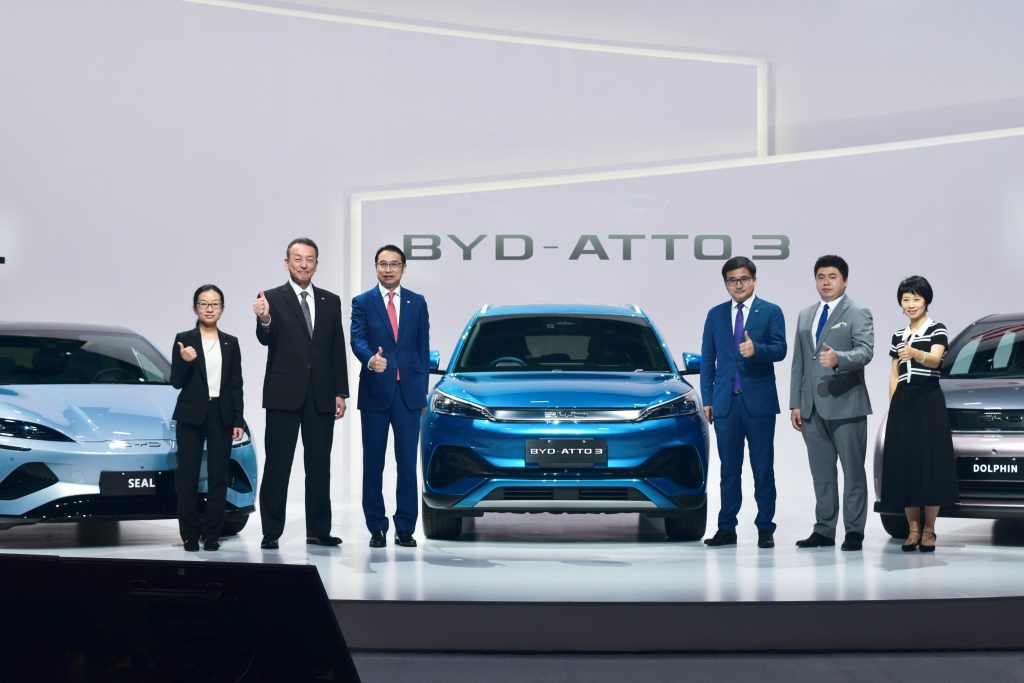In a historic turn of events, BYD, the Chinese electric vehicle (EV) powerhouse, outpaced Toyota in EV sales within its home market of Japan in 2024. This achievement marks a significant milestone, not only for BYD but also for the global EV industry, as it underscores the growing influence of Chinese automakers in markets traditionally dominated by legacy players.
Japan, known for its deep-rooted automotive culture and preference for domestic brands, has long been considered a challenging market for foreign manufacturers. Despite these obstacles, BYD’s strategic pricing, innovative vehicle lineup, and aggressive expansion have allowed it to penetrate this market effectively. Its sales growth contrasts sharply with the declining EV market in Japan, which saw a 33% year-over-year drop in 2024, the first decline in four years.
This article explores the key factors behind BYD’s success in Japan, the challenges facing the Japanese EV market, and the implications for both domestic and international automakers. Additionally, we examine how BYD’s achievements in Japan signify a broader shift in the global automotive landscape, where Chinese brands are emerging as formidable competitors.
As BYD continues to expand its footprint globally, its success in Japan serves as a microcosm of its ambitions to reshape the EV industry. How did BYD achieve such a feat in a market historically resistant to foreign brands? What does this mean for Japan’s automotive giants like Toyota and Nissan? And how will this milestone impact the broader global EV ecosystem? Let’s dive in.

BYD’s Strategic Approach to Penetrating the Japanese Market
BYD’s success in Japan is not a matter of luck but the result of a calculated and strategic approach to market penetration. Entering a market like Japan—known for its loyalty to domestic automakers and high standards of quality—requires more than just a competitive product. BYD’s approach has revolved around three core pillars: competitive pricing, a diversified product lineup, and an aggressive dealership expansion strategy.
Competitive Pricing
One of the most compelling aspects of BYD’s entry into Japan is its competitive pricing strategy. The BYD Dolphin, for instance, starts at just 2.99 million yen (approximately $19,000), making it one of the most affordable all-electric vehicles available in Japan. By offering high-quality EVs at prices significantly lower than those of domestic brands like Toyota and Nissan, BYD has positioned itself as a value-for-money alternative.
In contrast, Toyota’s bZ4X crossover starts at 5.5 million yen ($34,800), nearly twice the price of the Dolphin. This stark price difference makes BYD vehicles more accessible to cost-conscious consumers, especially as Japan’s economy faces challenges such as inflation and slower economic growth.
Diversified Product Lineup
Since its market entry in 2023, BYD has introduced a well-rounded lineup of electric vehicles tailored to meet diverse consumer needs. Starting with the Atto 3 crossover, known internationally as Yuan Plus, BYD expanded its offerings with the Dolphin hatchback and the Seal EV sedan. The Dolphin appeals to urban consumers looking for an affordable, compact electric vehicle, while the Seal sedan—positioned as an alternative to the Tesla Model 3—caters to those seeking a more premium option.
BYD is also planning to launch the Sealion 07 EV in 2025, a mid-sized electric SUV designed to compete with models like the Toyota RAV4 and Honda CR-V. This diversified product lineup allows BYD to target various market segments, from budget-conscious buyers to those looking for advanced features and performance.
Aggressive Dealership Expansion
BYD’s commitment to establishing a robust presence in Japan is evident in its ambitious dealership expansion plans. The company has announced it will open 100 stores in Japan by 2025, significantly increasing its accessibility to Japanese consumers. This move not only boosts visibility but also helps build trust and brand recognition in a market that has traditionally been wary of foreign automakers.
By focusing on customer experience and after-sales service, BYD aims to overcome one of the biggest barriers foreign brands face in Japan: the perception that they lack the reliability and support of domestic manufacturers.
Addressing Consumer Hesitations Toward EVs
Despite its success, BYD’s journey in Japan has not been without challenges. The Japanese market is known for its slow adoption of EVs, with EV penetration falling below 2% in 2024—one of the lowest among developed nations. Japanese consumers still favor hybrid vehicles, a segment dominated by Toyota and Honda.
To counter this, BYD has emphasized the affordability and long-term savings of its EVs, along with their cutting-edge technology. The company has also highlighted the environmental benefits of transitioning to fully electric vehicles, aligning with Japan’s broader sustainability goals.
Outselling Toyota: A Historic Milestone
BYD’s ability to outsell Toyota in EVs within just a year of entering the Japanese market is a testament to its effective strategy. While Toyota remains a dominant force in Japan’s overall automotive market, its relatively slow shift to EVs has created opportunities for competitors like BYD to fill the gap. BYD’s EV sales in Japan grew by 54% in 2024, while Toyota’s EV sales dropped by 30%, underscoring the effectiveness of BYD’s aggressive approach.
This milestone not only signifies a shift in Japan’s automotive landscape but also reflects the broader momentum of Chinese automakers in the global EV race. BYD’s success in Japan is just one chapter in a much larger story of how Chinese EV brands are challenging traditional automakers on their home turf.
The Global Implications of BYD’s Success in Japan
BYD’s triumph in the Japanese market carries far-reaching implications, not just for the automaker itself but for the global automotive industry. As Japan is one of the most challenging markets for foreign carmakers, BYD’s ability to penetrate and outperform domestic brands signals a shift in the dynamics of the global EV industry.
Challenging Japan’s Automotive Dominance
For decades, Japan has been synonymous with automotive excellence, with brands like Toyota, Nissan, and Honda setting the gold standard for quality, reliability, and innovation. However, BYD’s success challenges this dominance, marking the rise of Chinese automakers as formidable global players.
Japan has historically been resistant to foreign brands due to strong domestic loyalty, yet BYD’s rapid ascent shows that consumer preferences can shift when presented with high-quality, affordable alternatives. This success also pressures Japanese automakers to accelerate their transition to electric vehicles, a segment where they have lagged behind.
Accelerating the EV Transition in Developed Markets
BYD’s performance in Japan highlights the potential for rapid EV adoption in developed markets. Despite Japan’s traditionally low EV penetration—falling to less than 2% in 2024—BYD has demonstrated that affordability and value are key drivers for market entry.
This success story could serve as a case study for other markets where EV adoption has been slow. Countries with similar consumer hesitations or strong domestic automotive industries might also see increased competition from Chinese automakers like BYD, forcing a reevaluation of market strategies by legacy brands.
Expanding Chinese Influence in the Global EV Market
BYD’s accomplishments in Japan align with a broader trend: the global rise of Chinese EV makers. Companies like BYD, NIO, and XPeng are no longer content with dominating the Chinese market; they are aggressively expanding into Europe, Southeast Asia, and the Americas.
BYD’s strategy in Japan reflects its overall approach to global expansion: targeting developed markets with tailored products and competitive pricing while investing heavily in local infrastructure and customer support. This approach could be a blueprint for further success in regions where consumer trust in Chinese brands is still growing.
Pressure on Legacy Automakers
The rise of BYD and other Chinese EV makers intensifies the challenges faced by legacy automakers, particularly in markets like Japan where EV adoption has been slow. Companies like Toyota, which have been slower to transition from hybrids to fully electric vehicles, now face significant pressure to innovate and compete.
This competitive pressure could accelerate the global EV transition, with automakers investing more in research and development to match the affordability, performance, and innovation offered by Chinese brands.
Lessons for Other Markets
BYD’s ability to enter and succeed in a challenging market like Japan offers valuable insights for its global expansion strategy. Key lessons include:
- Localized Product Offerings: Tailoring vehicles to meet the specific needs of each market, as seen with the Dolphin and Seal models in Japan.
- Aggressive Pricing Strategies: Undercutting competitors without compromising on quality.
- Building Trust: Establishing a strong physical presence with dealerships and robust after-sales support.
By applying these lessons, BYD and other Chinese automakers could replicate their success in other markets, further solidifying their position as global EV leaders.
The Future of BYD and Its Global Impact
As BYD continues to make headlines with its impressive performance in Japan and other markets, it’s clear that the company is positioning itself to become a major player in the global automotive industry. Looking ahead, several key factors will influence BYD’s ability to maintain and expand its momentum, while shaping the future of the electric vehicle (EV) market worldwide.
Strategic Expansion into Global Markets
BYD’s strategic global expansion is key to its future success. While Japan marked an important victory in the company’s push to establish itself as a global EV leader, its sights are set on even larger markets. In Europe, for instance, BYD is increasing its presence with plans to introduce more models and expand its retail footprint. Europe’s growing interest in EVs, along with regulatory support for sustainable vehicles, offers a fertile ground for BYD to expand its footprint.
In the Americas, BYD has already begun making strides, with a presence in both North and South America. The company’s growth in these regions will likely follow the same strategy used in Japan: competitive pricing, high-quality vehicles, and strong customer support. The success in these diverse regions will not only boost BYD’s global sales but also establish the company as a serious competitor to established automotive giants like Tesla, Toyota, and Volkswagen.
Technological Advancements and Product Innovation
The future of BYD hinges on its ability to maintain its edge in technology and product innovation. With a focus on EVs, BYD has already proven its ability to deliver vehicles that meet the demands of both affordability and quality. However, as the competition heats up, BYD will need to continue to innovate in areas such as battery technology, autonomous driving, and vehicle connectivity to stay ahead of its rivals.
One area where BYD stands out is its expertise in battery production. The company is one of the largest manufacturers of lithium-ion batteries, which are crucial for EVs. BYD’s control over its battery supply chain gives it a significant advantage, ensuring the company has access to high-quality batteries at competitive prices. In the coming years, BYD is expected to further refine its battery technology, improving energy efficiency and reducing costs, which will ultimately make its vehicles even more attractive to consumers.
Sustainability and Green Technology
Another critical factor in BYD’s future success is its commitment to sustainability. As global demand for electric vehicles rises, so does the need for automakers to prioritize environmentally friendly practices across their operations. BYD has long been a leader in green technology, with a focus on reducing the carbon footprint of its vehicles and operations.
Beyond producing electric cars, BYD has also expanded its efforts into other forms of green transportation, including buses and trucks. These initiatives further align with the growing global push for sustainable mobility solutions, positioning BYD as a leader in the wider clean transportation sector. As governments worldwide ramp up their environmental policies and push for net-zero emissions, BYD’s sustainable practices could give it a competitive edge in the years to come.
Facing Increased Competition
While BYD’s success is undeniable, the company will face increased competition as the EV market continues to expand. Legacy automakers like Toyota, Volkswagen, and General Motors are ramping up their electric vehicle offerings, with new models and innovative technologies coming to market. In addition, newer players like Tesla and Rivian are pushing the envelope on electric vehicle performance and consumer appeal.
To stay ahead of the competition, BYD must continue to innovate and adapt to changing market conditions. This will include maintaining strong relationships with consumers through marketing and after-sales services, expanding its product lineup, and ensuring that its vehicles remain competitive in terms of pricing, performance, and design.
The Long-Term Outlook: Will BYD Top Global Sales?
Looking further into the future, one question remains at the forefront: can BYD surpass Toyota to become the top-selling global automaker? While Toyota has long been the dominant player in global vehicle sales, the rise of EVs presents a unique opportunity for BYD to dethrone the Japanese giant, especially as Toyota’s slow shift toward electric vehicles continues to hinder its growth in the EV sector.
BYD’s aggressive expansion plans, technological prowess, and sustainable practices position it as a strong contender for global dominance. However, whether or not the company can outpace Toyota in global sales will depend on how effectively it navigates the challenges of competition, regulatory hurdles, and consumer preferences across diverse markets.
Conclusion: A Bright Future for BYD
In conclusion, BYD’s success in Japan and its ongoing global expansion mark the beginning of a new era for the company and the electric vehicle industry. With a strategic focus on affordability, innovation, and sustainability, BYD is well-positioned to lead the charge in the global shift toward electric mobility. As the world embraces clean energy and sustainable transportation solutions, BYD’s continued growth and market presence will have a significant impact on the automotive landscape.
For businesses and consumers alike, BYD’s future trajectory represents an exciting opportunity to witness the rise of a new global automotive leader that is shaping the future of transportation.

